ANIMAL ORGAN SYSTEMS AND HOMEOSTASIS
Table of
Contents
Homeostasis | The
Internal Environment | Control
Systems |
Feedback Systems in Homeostasis
Body Systems and
Homeostasis | Links
Animal organs are usually composed of more than
one cell type. Organs perform a certain function. Most organs have
functions in only one organ system. Organ systems are composed of
organs, and perform a major function for the organism.
Homeostasis
is the maintenance of a stable internal environment. Homeostasis is a
term coined in 1959 to describe the physical and chemical parameters
that an organism must maintain to allow proper functioning of its
component cells, tissues, organs, and organ systems. Single-celled
organisms are surrounded by their external environment. Most
multicellular organisms have most of their cells protected from the
external environment, having them surrounded by an aqueous internal
environment. This internal environment must be maintained in such a
state as to allow maximum efficiency. The ultimate control of
homeostasis is done by the nervous system. Often this control is in
the form of negative feedback loops. Heat control is a major function
of homeostatic conditions that involves the integration of skin,
muscular, nervous, and circulatory systems.
Multicellular organisms have a series of
organs
and organ
systems that function in homeostasis.
Changes in the external environment can trigger changes in the
internal environment as a response.
The
Internal Environment | Back
to Top
There are two types of extracellular fluids in
animals:
- the extracellular fluid that surrounds and
bathes cells
- plasma,
the liquid component of the blood.
Internal components of homeostasis:
- Concentration of oxygen and carbon
dioxide
- pH of the internal environment
- Concentration of nutrients and waste
products
- Concentration of salt and other electrolytes
- Volume and pressure of extracellular
fluid
Open systems are linear and have no feedback, such
as a light switch. Closed Systems has two components: a
sensor
and an effector,
such as a thermostat (sensor) and furnace (effector). Most
physiological systems in the body use feedback to maintain the body's
internal environment.
Extrinsic
Most homeostatic systems are extrinsic: they are
controlled from outside the body. Endocrine
and nervous
systems are the major control systems in higher animals.
The nervous system depends on sensors in the skin
or sensory organs to receive stimuli and transmit a message to the
spinal
cord or brain. Sensory input is processed
and a signal is sent to an effector system, such as muscles or
glands, that effects the response to the stimulus.
The endocrine system is the second type of
extrinsic control, and involves a chemical component to the reflex.
Sensors detect a change within the body and send a message to an
endocrine effector (parathyroid), which makes PTH. PTH is released
into the blood when blood calcium levels are low. PTH causes bone to
release calcium into the bloodstream, raising the blood calcium
levels and shutting down the production of PTH.
Some reflexes have a combination of nervous and
endocrine response. The thyroid gland secretes thyroxin (which
controls the metabolic
rate) into the bloodstream. Falling levels of thyroxin stimulate
receptors in the brain to signal the hypothalamus to release a
hormone that acts on the pituitary gland to release thyroid-stimulating
hormone (TSH) into the blood. TSH acts on
the thyroid, causing it to increase production of thyroxin.
Intrinsic
Local, or intrinsic, controls usually involve only
one organ or tissue. When muscles use more oxygen, and also produce
more carbon dioxide, intrinsic controls cause dilation of the blood
vessels allowing more blood into those active areas of the muscles.
Eventually the vessels will return to "normal".
Feedback
Systems in Homeostasis | Back
to Top
Negative
feedback control mechanisms (used by most
of the body's systems) are called negative because the information
caused by the feedback causes a reverse of the response. TSH is an
example: blood levels of TSH serve as feedback for production of
TSH.
Positive
feedback control is used in some cases.
Input increases or accelerates the response. During uterine
contractions, oxytocin
is produced. Oxytocin causes an increase in frequency and strength of
uterine contractions. This in turn causes further production of
oxytocin, etc.
Homeostasis depends on the action and interaction
of a number of body systems to maintain a range of conditions within
which the body can best operate.
Body
Systems and Homeostasis | Back
to Top
Eleven major organ systems are present within
animals, although some animals lack one or more of them. The
vertebrate body has two cavities: the thoracic,
which contains the heart and lungs; and the abdominal, which contains
digestive organs. The head, or cephalic region, contains four of the
five senses as well as a brain encased in the bony skull. These organ
systems can be grouped according to their functions.

The above image is modified from http://www.whfreeman.com/life/update/.
- Muscular
System allows movement and locomotion.
The muscular system produces body movements, body heat, maintains
posture, and supports the body. Muscle
fibers are the main cell type. Action
of this system is closely tied to that of the skeletal system.
- Skeletal
System provides support and protection,
and attachment points for muscles. The skeletal system provides
rigid framework for movement. It supports and protects the body
and body parts, produces blood cells, and stores
minerals.
- Skin or
Integument is the outermost protective
layer. It prevents water loss from and invasion of foreign
microorganisms and viruses into the body. There are three layers
of the skin. The epidermis is the outer, thinner layer of skin.
Basal cells continually undergo mitosis. Skin is waterproof
because keratin, a protein is produced. The next layer is the
dermis a layer of fibrous connective tissue. Within the dermis
many structures are located, such as sweat glands, hair follicles
and oil glands. The subcutaneous layer is composed of loose
connective tissue. Adipose tissue occurs here, serving primarily
for insulation. Nerve cells run through this region, as do
arteries and veins.
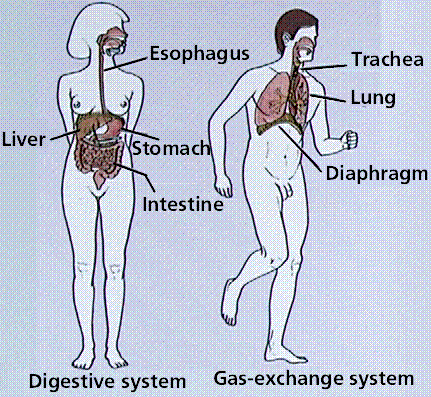
The above image is modified from http://www.whfreeman.com/life/update/.
- Respiratory
System moves oxygen from the external
environment into the internal environment; also removes carbon
dioxide. The respiratory system exchanges gas between
lungs
(gills in fish) and the outside environment. It also maintains pH
of the blood and facilitates exchange of carbon dioxide and
oxygen.
- Digestive
System digests and absorbs food into
nutrient molecules by chemical and mechanical breakdown;
eliminates solid wastes into the environment. Digestion is
accomplished by mechanical and chemical means,breaking food into
particles small enough to pass into bloodstream. Absorbtion of
food molecules occurs in the small
intestine and sends them into
circulatory system. The digestive system also recycles water and
reclaims vitamins from food in the large
intestine.
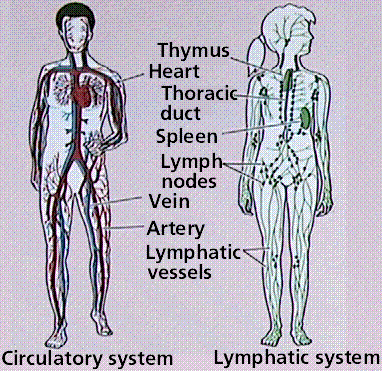
The above image is modified from http://www.whfreeman.com/life/update/.
- Circulatory
System transports oxygen, carbon
dioxide, nutrients, waste products, immune components, and
hormones. Major organs include the heart, capillaries, arteries,
and veins. The lymphatic system also transports excess fluids to
and from circulatory system and transports fat to the
heart.
- Immune
System defends the internal environment
from invading microorganisms and viruses, as well as cancerous
cell growth. The immune system provides cells that aid in
protection of the body from disease via the antigen/antibody
response. A variety of general responses are also part of this
system.
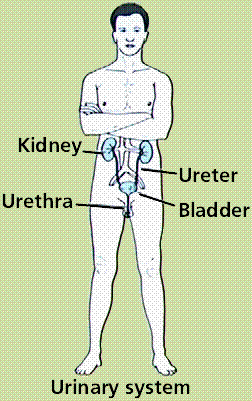
The above image is modified from http://www.whfreeman.com/life/update/.
- Excretory
System regulates volume of internal
body fluids as well as eliminates metabolic wastes from the
internal environment. The excretory system removes organic wastes
from the blood, accumulating wastes as urea in the kidneys. These
wastes are then removed as urine. this system is also responsible
for maintaining fluid levels.
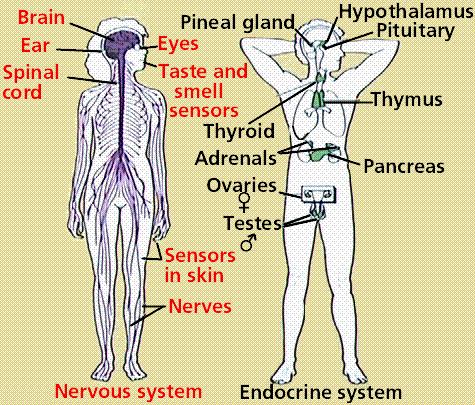
The above image is modified from http://www.whfreeman.com/life/update/.
- Nervous
System coordinates and controls actions
of internal organs and body systems. Memory, learning, and
conscious thought are a few aspects of the functions of the
nervous system. Maintaining autonomic functions such as heartbeat,
breathing, control of involuntary muscle actions are performed by
some of the parts of this system.
- Endocrine
System works with the nervous system to
control the activity internal organs as well as coordinating
long-range response to external stimuli. The endocrine system
secretes hormones
that regulate body metabolism, growth, and reproduction. These
organs are not in contact with each other, although they
communicate by chemical messages dumped into the circulatory
system.
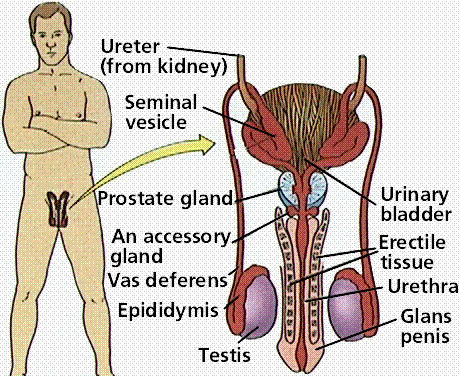
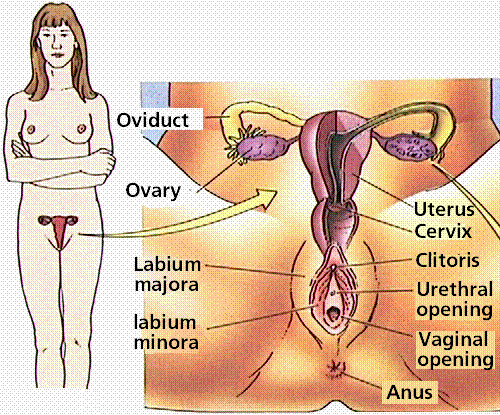
The above images are modified from http://www.whfreeman.com/life/update/.
- Reproductive
System is mostly controlled by the
endocrine system, and is responsible for survival and perpetuation
of the species. Elements of the reproductive system produce
hormones (from endocrine control) that control and aid in sexual
development. Organs of this system produce gametes that combine in
the female system to produce the next generation (embryo).
- Organ
Systems of the Body A health-related view of the body organ
systems.
- How
the Body Works A Canadian site with way cool "fig"
leaves!
- Homeostasis
A collection of links dealing with organ systems and
homeostasis.
- The
Atlas of the Human Body An online atlas from the American
Medical Association. Check out the system of your choice.
- The Virtual
Body This site presents information about the Brain, Digestive
System, Heart, and Skeleton through use of a series of
Shockwave® animations. You will need the plugin to view those
animations, but can access it from the Virtual Body site.
- Human
Anatomy Online This site offers some Java-assisted fun
activities about the human body.
- Human
Anatomy and Physiology Case Study Project Learn about human
anatomy and physiology by studying actual cases.
- Vesalius, an online
graphical resource for the medical and surgical communities
This site provides anatomical illustrations, many of which are
posted for your viewing. An interesting feature is the mark up
section, allowing registered users (registrations is currently
free) to annotate posted drawings.
- Virtual
Pig Dissection No fuss, no muss, no smell, no wastes to
dispose of. This site, intended for high school level, offers
systemic information about a commonly dissected specimen, Babe the
Pig!
- Atlas
Plus Virtual demonstrations covering aspects of anatomy and
body systems, but not the histology section (University of
Michigan). This site uses Java, so your browser will need to be
Java-compliant.
- Click
the Bones and They Will Speak Not just for Haloween fun, this
site offers some very well done information about the bones and
how to properly pronounce them. Maybe with this site I might not
have left animals for plant science!
- Online
Biology Book chapters covering the human body and its organ
systems.
Text ©1992, 1994, 1997, 1998, 1999, 2000, M.J. Farabee, all
rights reserved, although use for educational purposes is very much
encouraged and appreciated!
Back to Table of Contents
| THE INTEGUMENTARY
SYSTEM
Email: mj.farabee@emcmail.maricopa.edu
Last modified: 2000/01/05:08:46:01
The URL of this page is: gened.emc.maricopa.edu/bio/BIO181/BIOBK/BioBookANIMORGSYS.html








![]()